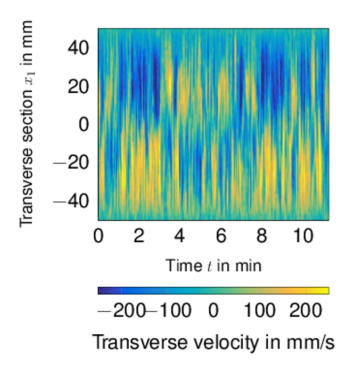Response of a Turbulent von Karman Swirling Flow to Anisotropy at the Molecular Scale
Hanna Berning, Tim Grünberg, Thomas Rösgen
Motivation
We ask if and how the large scale structure of a turbulent von Karman swirling flow depends on anisotropies introduced at the smallest scales. We generate such anisotropy on the viscous scale in a paramagnetic colloid whose rheology is modified by an external, uniform magnetic field.
Experimental Setup
We create a highly turbulent flow in a cylindrical container driven by two counter-rotating discs. This flow topology, known as von Karman flow, is widely used in experiments on turbulent flows. Due to topological symmetry there is isotropy in the transverse directions, the plane in which we apply an uniform magnetic field B.

The experiments were conducted with an aqueous ferrofluid (sicastar-M 350, micromod Partikeltechnologie GmbH, Germany). Under the influence of an external magnetic field the particles in the fluid form short linear chains which are preferentially aligned in the field direction. The resulting anisotropic response to shearing motions and its impact on the flow can be conceptualised by a direction dependent viscosity.

Since ferrofluids are opaque at optical wavelengths, the flow velocities were measured using ultrasound velocimetry techniques. We used a commercial instrument (DOP3010, Signal Processing SA, Switzerland) to measure transverse velocity profiles in directions parallel (x1-direction) and perpendicular (x2-direction) to the magnetic field.
Flow without Magnetic Field

The following plot shows the variation of one transverse velocity profile over time. The system spontaneously jumps between two different flow states. This structure might consist of vortices which fluctuate in azimuthal position and originate from a Kelvin-Helmholtz-instability
Flow with Viscosity-Induced Anisotropy
The structure of the large scale flow shows a clear dependency on the magnetic field.
In the field-free case, two distinct velocity modes occur with near equal probability. Under magnetic field influence, the occurrence probability of the modes changes depending on the direction to the magnetic field. With increasing field mode 1 is favoured in the field-parallel direction while mode 2 is favoured in the field-perpendicular direction.
With increasing field magnitude, a clear bifurcation behaviour could be observed, with one mode being favoured in the field-parallel direction whereas the second became dominant in the perpendicular direction. The measurements thus revealed a field dependent, spatially anisotropic behavior of the turbulent von Karman flow established in the test cell. The primary and presumably only cause for these modifications is the anisotropic viscosity.
Ongoing research
In order to separate the effect of the anisotropy on the viscosity level from existing bifurcations that typically occur in a von Kármán flow, we propose a random forcing.
By reversing the disc rotation sense pseudo-randomly, flow reversal is suppressed and only the poloidal inward pumping remains at sufficiently high change rates. The turbulence properties are improved towards isotropy and statistical stationarity which is supported by resolved local Lagrangian measurements, as well as global ultrasound and PIV measurements.


